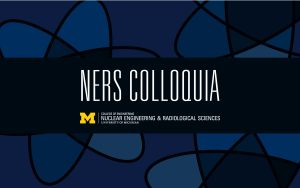Presented By: Nuclear Engineering & Radiological Sciences
NERS Colloquia Series: Glenn Knoll Lecture
Josh Grindlay, Harvard

Speaker: Josh Grindlay, Center for Astrophysics, Harvard & Smithsonian
"Development of the High Resolution Energetic X-ray Imager (HREXI)"
There are many science goals for HREXI as the imaging detector (16 x 16 CZTs/ASICs) for a coded aperture telescope on 2 SmallSats to be proposed in 2023 as a Small Explorer (SMEX) mission in 2028 followed by 10 additional SmallSats for a MIDEX mission to be proposed in 2028 that would enable (by 2030) the very first Full-Sky, continuous viewing, high-resolution imaging and spectra of Gamma-Ray Bursts (GRBs) from the collapse to stellar mass (~10 - 30 solar mass) black holes from the very first massive stars (PopIII) formed ~100 million years after the Big Bang. These stars cannot individually be observed by the JWST telescope, but HREXI imaging CZT arrays can readily detect their extremely luminous (in X-, Gamma-rays) GRBs and provide measurements of the epoch (in redshift) of these very first massive stars that ionized the Universe. This talk will be mainly about the CdZnTe (CZT) detectors and their readout from 3 - 300 keV for imaging and spectra.
"Development of the High Resolution Energetic X-ray Imager (HREXI)"
There are many science goals for HREXI as the imaging detector (16 x 16 CZTs/ASICs) for a coded aperture telescope on 2 SmallSats to be proposed in 2023 as a Small Explorer (SMEX) mission in 2028 followed by 10 additional SmallSats for a MIDEX mission to be proposed in 2028 that would enable (by 2030) the very first Full-Sky, continuous viewing, high-resolution imaging and spectra of Gamma-Ray Bursts (GRBs) from the collapse to stellar mass (~10 - 30 solar mass) black holes from the very first massive stars (PopIII) formed ~100 million years after the Big Bang. These stars cannot individually be observed by the JWST telescope, but HREXI imaging CZT arrays can readily detect their extremely luminous (in X-, Gamma-rays) GRBs and provide measurements of the epoch (in redshift) of these very first massive stars that ionized the Universe. This talk will be mainly about the CdZnTe (CZT) detectors and their readout from 3 - 300 keV for imaging and spectra.